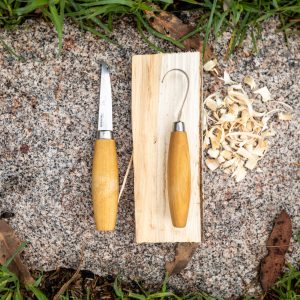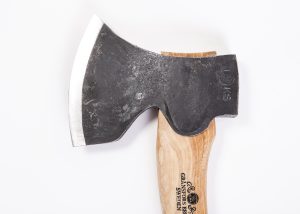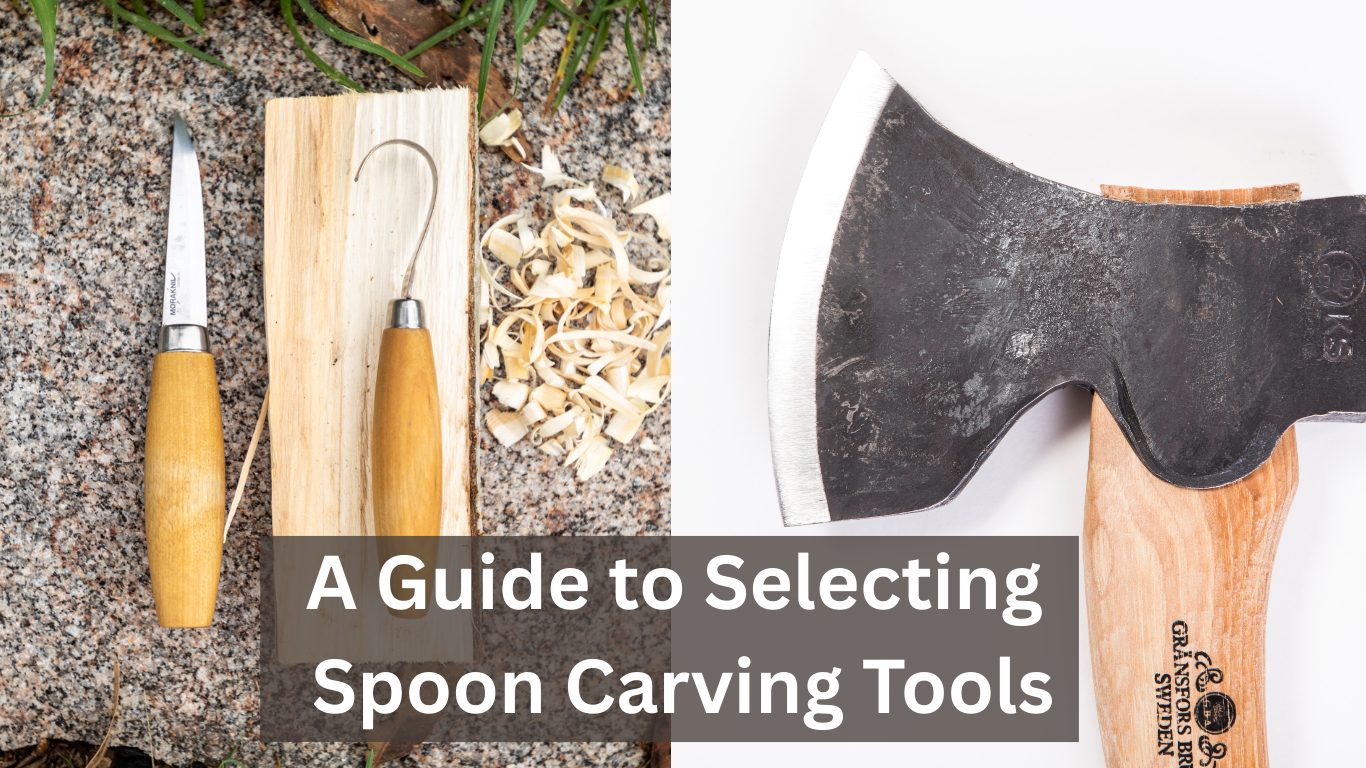Spoon carving is a deeply satisfying craft, connecting you to nature and allowing you to create beautiful, functional objects. But before you can whittle your way to wooden wonder, you need the right tools. This guide will walk you through the essentials of selecting spoon carving tools, helping you choose the perfect set for your carving journey.
The Dynamic Duo: What Tools Do You Need for Spoon Carving?
While advanced carvers might have a vast collection, you can start with just two core tools:
- Hook Knife (or Spoon Knife): This is the heart of spoon carving. Its curved blade is designed to hollow out the bowl of the spoon. Hook knives come in various sizes and curvatures, so consider the size and shape of spoons you want to create. Right-handed and left-handed versions are available, so be sure to choose the correct one. Brands like Morakniv offer excellent hook knives known for their sharpness and durability. I use and recommend the Morakniv 164 which is a single-sided knife available for both right and left handed carvers.
- Straight Knife (or Sloyd Knife): Used for roughing out the shape of the spoon blank, shaping the handle, and refining the outer surfaces. A good straight knife should have a sharp, sturdy blade and a comfortable handle. Look for a blade that’s easy to control for both push and pull cuts. I use a Morakniv 106 and 120 which are both made of carbon steel.
Beyond the Basics: Expanding Your Tool Kit
Once you’re comfortable with the core tools, you might consider adding these to your collection:
- Carving Axe: For roughing out larger blanks, a carving axe or hatchet speeds up the process. I use Gransfors Bruk large carving axe, Gransfors Bruk hand-hatchet and a Robin Wood Carving Axe. You only need one axe though and for starting out I’d suggest the Gransfors Bruk Wildlife Hatchet. It’s comparable in size to the Robin Wood at 600g.
- Folding Saw: Essential for cutting the initial spoon blank from a larger piece of wood as well as stop cuts to protect the bowl when roughing out with an axe. Opinel do an excellent sharp saw. The No 18 can deal with decent size branches and there are replacement blades available. For a smaller compact version saw try the Opinel No12.
- Sharpening Tools: A sharp tool is a safe tool. A strop is an essential part of your sharpening kit as well as sharpening options including hook knife sharpening kit. Blunt tools are dangerous and take the joy out of carving. A leather strop with honing compound for your straight knives and a hook knife sharpening and honing kit for your hook knives will keep things in top shape.
Factors to Consider When Choosing Tools:
- Blade Material: High carbon steel is a popular choice for carving tools as it holds an edge well and is relatively easy to sharpen. Stainless steel is more resistant to rust but can be harder to sharpen. The Morakniv 120 & 106 models use high carbon steel, and the 164 hook knife is stainless steel.
- Handle Material: A comfortable handle is crucial for long carving sessions. Wood, plastic, and composite materials are all common choices. Consider the ergonomics and how the handle feels in your hand. Morakniv often uses beech for their handles and these are able to be shaved down to fit the users hand if so desired.
- Quality: Investing in quality tools will pay off in the long run. Well-made tools will last longer, hold their edge better, and be more enjoyable to use. I use Morakniv, and Gränsfors Bruk as they are highly respected brands known for their quality and value.
- Price: Spoon carving tools can range in price from affordable to quite expensive. Start with a basic set and gradually add more tools as your skills and budget allow. Morakniv offer tools at a good price point, making them accessible to beginners and experienced carvers alike. Gränsfors Bruk axes are a premium investment but are known for their exceptional quality. There are cheaper brands available but they often mean lower quality, more sharpening and therefore less enjoyment. At the end of the day, buy the best tools you can afford.
Tips for Choosing Your First Set:
- Read reviews: See what other carvers have to say about different brands and models, including specific Opinel and MoraKniv tools.
- Try before you buy (if possible): I use MoraKniv, sloyd and hook knives in my workshops (the same tools I use) so you can see how they feel. You can also try my Gransfors Bruk and Robin Wood axes.
- Don’t be afraid to ask for advice: Experienced carvers are often happy to share their knowledge.
Caring for Your Tools:
- Keep them sharp: Regular honing is essential for safe and efficient carving.
- Store them properly: Protect your tools from damage by storing them in a safe place. Keep sheaths on knives and if in high humidity store with moisture sachets.
- Clean them after use: Remove any wood shavings or debris from your tools after each carving session.
Choosing the right spoon carving tools is a personal journey. Experiment, try different tools, and find what works best for you. With quality brands like Opinel, MoraKniv, and the addition of a roughing-out axe from a brand like Gränsfors Bruk, you’ll be well on your way to creating beautiful and functional spoons that you can cherish for years to come.
Browse our shop for all your spoon carving needs, or join one of our workshops to learn the craft and try our tools firsthand.
Happy carving!

Carving and whittling knives Morakniv brand. A straight knife on the left ad hook knife on the right.

Swedish-made Gränsfors Bruk 475 Carving Axe, showcasing exceptional hand-forging and traditional craftsmanship.

